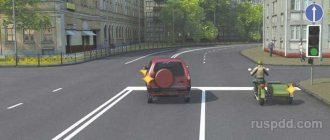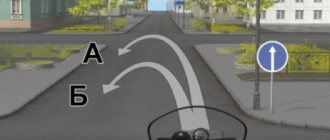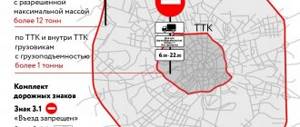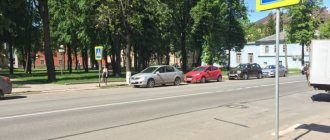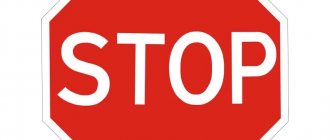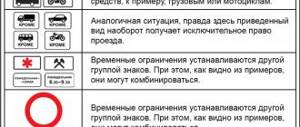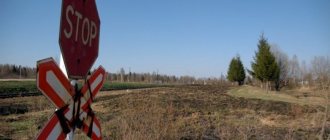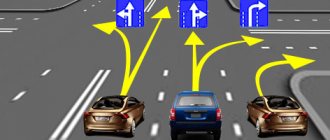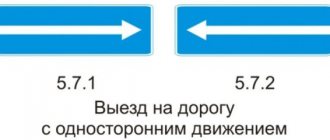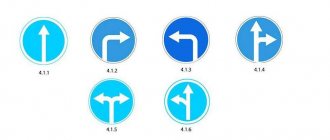Sign 4.1.1 “Move straight”
Road sign 4.1.1 “Move straight ahead” is used to prohibit turns and U-turns at the nearest intersection of roadways, and to indicate movement only in the forward direction.
The sign is installed directly in front of the intersection (crossroads, exit from the adjacent territory, break in the dividing strip, passage, etc.), to the right of the road.
On narrow roads, it is allowed to install a duplicate sign 4.1.1 on the left side of the road so that it is visible to drivers if for some reason the sign installed on the right side remains unnoticed.
On wide roads, when there are two or more lanes in one direction, the “Go straight” sign is duplicated above the left lane.
To prohibit turning around in breaks in the dividing strip in areas between intersections, sign 4.1.1 is installed on the dividing strip.
Effective area of sign 4.1.1 “Move straight ahead”
The “Go straight ahead” sign installed before the intersection of roadways is valid only for this intersection.
Sign 4.1.1 can be installed at the beginning of a section of the road, for example, immediately after an intersection, to duplicate markings 1.1 (solid) or 1.3 (double solid), separating oncoming traffic flows. With this installation, the sign does not prohibit turning right into courtyards and other areas adjacent to the road on the right.
The effect of the “Go straight ahead” sign installed at the beginning of the road section extends to the next nearest intersection.
Sign 4.1.1 does not apply to route vehicles.
Mandatory traffic signs.
Prescriptive signs order the driver to move in one direction or another.
The first sign is 4.1.1 - this is moving straight.
The sign commands! go straight.
The sign can be placed in two cases:
- before the intersection,
- in front of the road section.
Installing a “go straight ahead” sign in front of the intersection.
The “go straight ahead” sign has a coverage area. If a “go straight” sign is installed in front of an intersection, then its coverage area is the first intersection of roadways.
Remember, if there is a dividing strip at an intersection, then there will be several intersections.
Let's look at this picture from the tickets
Now we see a “straight ahead only” sign installed in front of the intersection.
This is a simple intersection, here one roadway intersects with another roadway.
Yes, the coverage area of this sign is the first intersection of roadways, but now there is only one intersection at the intersection, so the sign will be valid for the entire intersection.
Let's look at the problem more difficult
Now we are faced with a complex intersection with two intersections of roadways.
The “go straight ahead” sign applies to the first intersection .
Intersections are counted in the direction the driver is moving, so turning at the first intersection along path A will be prohibited. A U-turn at the second intersection along trajectory B is not prohibited, since the sign is no longer valid there.
In the picture below there is a similar intersection with two intersections, the first one you must drive straight, and the second one, you can go along both trajectory B and trajectory A.
Installing a “go straight ahead” sign in front of the road section.
The next case of installing a “go straight” sign is in front of a section of the road. With this installation, the sign is valid until the nearest intersection. Like in this picture.
The sign's coverage area is from the installation site to the nearest intersection; at the intersection itself you can go anywhere.
In the case where the sign is located in front of a section of the road, the sign’s coverage area is not interrupted if there is an entrance to the yard, but at the same time, the sign does not prohibit turning right into the courtyards; it will not be possible to turn left into the yard, but it will be possible to turn right into the yard.
Always pay attention to the place where the road sign is installed
Now the sign is installed before the intersection, and after the intersection it is not valid.
The injunction sign is to move to the right.
The next road sign is “move to the right”
The coverage area of this road sign is also the first intersection of roadways. When the driver sees this sign, he is ordered to turn right.
Look at this picture - it's a complex intersection. There are two road crossings here. And two trajectories of movement to the right along trajectory A and along trajectory B.
But we are now prohibited from moving along trajectory B to the right into the second passage, since in order for the driver to get to the second intersection, he needs to drive straight - the first intersection of roadways, and he is now obliged to turn right.
The correct answer is along path A.
Sign requiring movement to the left.
The next sign is to move left.
Remember that this sign ordering a left turn also allows a U-turn.
Let's look at this picture.
Before the intersection there is a sign “moving left”. He orders a left turn, but also allows a U-turn.
Therefore, the correct answer will be along trajectory B, and besides, the driver is in the far left lane. A and B – movement is prohibited.
Sign 4.1.2 “Move to the right”
Road sign 4.1.2 “Move to the right” is used to indicate the direction of movement at the nearest intersection of roadways only to the right.
On wide roads the “Move to the right” sign is duplicated. Duplicate sign 4.1.2 is installed above the left lane, on roads with a dividing strip - on the dividing strip, and on narrow roads without a dividing strip - on the left side of the road.
The coverage area of sign 4.1.2 “Move to the right” extends to the intersection of roadways in front of which the sign is installed (to the first intersection behind the sign).
Sign 4.1.2 does not apply to route vehicles.
Non-alternative signs
Sign 4.1.2 “Move to the right” indicates movement along the path prescribed by the arrow (to the right).
For example, gas stations are equipped with this symbol to ensure the safe movement of a car entering busy highways and highways. The functioning of the arrow contains nuances:
- You should turn right from the far right lane of the road.
- The symbol is installed before the intersection.
- Action - only at the first fork in the road.
- Not required for route transport.
The last point is especially worth remembering for inexperienced drivers who are repeating the maneuvers of the vehicle in front. Such imitation constitutes a gross offense and a danger of causing an accident. The fine for ignoring a mandatory symbol is set at 1,000 – 1,500 rubles.
Signpost 4.1.3 “Move to the left” determines the route of movement of the vehicle according to the image of the arrow (to the left). The symbol is mounted before the fork in the road and loses its force immediately after it. You should know that a left turn maneuver does not exclude a U-turn.
Sign 4.2.1 “Avoiding an obstacle on the right” gives an idea of how to go around an obstacle (on the right).
The prescriptive nature of the symbol helps to stabilize the road situation when:
- carrying out repair or cleaning work;
- activation of the dividing strip;
- the appearance of a safety island and other things.
If it is possible to go around an obstacle on the left, the driver is not recommended to do this in order to avoid an accident and a fine.
The symbol operates in the area where an object is located that impedes movement. After passing the obstacle, you should return to your lane and drive as usual. Typically, motorists try to avoid obstacles on the right without leaving their lane. But sometimes conditions arise that prevent safe detour. In these cases, the solution to the problem of passing the obstacle is to install the sign 4.2.2 “Avoiding the obstacle on the left.”
The symbol instructs you to go around obstacles on the left edge; accordingly, if it is possible to go around them to the right, this should not be done.
Often, the symbol is equipped with vehicles of municipal and road services responsible for the improvement of streets: repair and cleaning activities, watering of plantings along highways and streets. Sometimes the prescription contradicts the markings, represented by a solid or double solid line. Then one must adhere to the principle of advantage, that is, follow the instructions of the symbol.
The designation “Detour on the left” does not give privileges to the driver in front of vehicles traveling on the opposite path.
Sign 4.1.4 “Move straight or right”
Road sign 4.1.4 “Move straight or to the right” is used to indicate the direction of movement at the nearest intersection of roadways only straight or to the right.
On wide roads the “Go straight or right” sign is duplicated. Duplicate sign 4.1.4 is installed above the left lane, on roads with a dividing strip - on the dividing strip, and on narrow roads without a dividing strip - on the left side of the road.
The coverage area of sign 4.1.4 “Moving straight or to the right” extends to the intersection of roadways in front of which the sign is installed (to the first intersection behind the sign).
Sign 4.1.4 does not apply to route vehicles.
What does the “Go straight or left” sign mean?
The straight ahead or left sign looks like a round blue sign with white arrows drawn on it.
Cars move in the direction of the signs. With the help of warning stencils, the rules regulate driving on the most dangerous sections of the road:
- drive straight through the intersection;
- turn;
- turn left.
The sign warns that it is prohibited to make a right turn. Every driver knows how difficult it is to drive through intersections where there are no traffic lights; signs with arrows help avoid chaos on the road and regulate traffic order. It is necessary to take into account the management of route vehicles. These signs only regulate the movement of ordinary cars, without preventing MTS from transporting passengers along their routes; they can turn right.
Fines for violating regulatory signs 4.1.1-4.1.6
The size of the fine for mandatory signs will depend not only on the fact of the violation itself, but also on the consequences to which this violation will lead. For example, by violating the requirement of the sign and turning “wrong”, you can drive towards the traffic. And for this violation there are already serious sanctions.
For failure to comply with the requirements of mandatory signs indicating the proper direction of movement (for the very fact of violation), sanctions will be imposed on the driver in the form of a warning or a fine of 500 rubles. under Part 1 of Article 12.16 of the Administrative Code.
For turning left or making a U-turn in violation of the requirements prescribed by road signs, a fine of 1000-1500 rubles will be imposed under Part 2 of Article 12.16 of the Administrative Code.
But if turning in violation of the instructional sign leads to the car driving towards the traffic, this action will be regarded as moving in the opposite direction (Article 12.16 part 3 of the Administrative Code - a fine of 5,000 rubles or deprivation of rights for up to six months). A repeated violation will result in deprivation of rights for 1 year or a fine of 5,000 rubles.
A complete list of mandatory road signs with brief comments (explanations) on the website is available in Appendix 1 of the Traffic Regulations.
Navigation through the series of articles<< Mandatory road signs Mandatory road signs 4.2 - 4.3 >>
Alternative signs
There are several signs that provide for variability of choice:
- Symbol 4.1.4 “Move straight or right” determines the course according to the location of the arrows on the sign (straight or right). You must turn right, keeping to the right lane of the highway. The pointer is mounted before the upcoming branching path and is active exclusively on it. The fine for non-compliance with the instructions is 1,000 - 1,500 rubles.
- Pointer 4.1.5 “Move straight or left” sets the vector of movement according to the configuration of the arrows (straight or left). The designation is mounted to the nearest fork and has meaning only for it. The regulation does not apply to route vehicles.
- Sign 4.1.6 “Moving right or left” allows you to choose a route suggested by a combination of arrows (right and left). The rule can be ignored by route vehicles. The symbol can be found before the start of the intersection and followed exclusively at the first fork in the paths. So, signs 4.1.1 - 4.1.6 do not affect the movement of route transport. Signs 4.1.3, 4.1.5, 4.1.6 do not prohibit turning.
- Sign 4.2.3 “Avoiding an obstacle on the right or left” gives a choice of two lines to overcome the obstacle. To avoid getting into the opposite flow, it is preferable to go around the obstacle on the right.
The absence of markings 4.2.1, 4.2.2, 4.2.3 is supplemented by clause 9.12 of the traffic rules, which states: “On two-way roads in the absence of a dividing strip, traffic islands, bollards and elements of road structures (supports of bridges, overpasses, etc.) located on the middle of the roadway, the driver must pass on the right unless signs and markings indicate otherwise.”
